
The Peruvian Aprista Party is a Peruvian political party and a member of the Socialist International. The party was founded as the American Popular Revolutionary Alliance by Víctor Raúl Haya de la Torre, who originally intended to create a network of anti-imperialist social and political movements in Latin America. Members are called "compañeros", based on the fraternity espoused by Haya de la Torre. Originally a centre-left to left-wing party with democratic socialist and nationalist elements, the party moved closer to the political centre under the leadership of Alan García starting in the 1980s, embracing social democracy and later some Third Way policies. In 2006, the party adopted a new platform as García's second presidency implemented a series of policies labelled as centre-right, embracing free-market capitalism, dialogue with other right-wing parties and organizations in the country, and closer ties with the Catholic Church and Evangelical churches.

Union for Peru is a Peruvian political party founded by Javier Pérez de Cuéllar, an ex-UN Secretary General, in 1994 to run for the presidency of Peru in the 1995 general elections. Originally a social democratic party, the party became the main political home of the Peruvian ethnocacerist movement in the late-2010s after a group led by former Army Major Antauro Humala joined the party. Humala later formed the Patriotic Front in 2018 and contested the 2021 general elections.
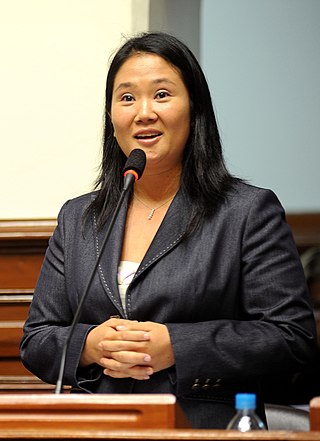
Keiko Sofía Fujimori Higuchi is a Peruvian politician. Fujimori is the eldest daughter of former Peruvian president Alberto Fujimori and Susana Higuchi. From August 1994 to November 2000, she held the role of First Lady of Peru, during her father's administrations. She has served as the leader of the Fujimorist political party Popular Force since 2010, and was a congresswoman representing the Lima Metropolitan Area, from 2006 to 2011. Fujimori ran for president in the 2011, 2016, and 2021 elections, but was defeated each time in the second round of voting.

Ollanta Moisés Humala Tasso is a Peruvian politician and former military officer who served as President of Peru from 2011 to 2016. Originally a socialist and left-wing nationalist, he is considered to have shifted towards neoliberalism and the political centre during his presidency.

National Solidarity Party, was a conservative Peruvian political party. Founded in 1998 for the 2000 general election to support the candidacy of Luis Castañeda Lossio, a former Lima City Council member from Popular Action. Following the end of Alberto Fujimori's regime, the party formed the National Unity coalition with the Christian People's Party and other minor parties. Led by Lourdes Flores, the coalition placed third at the 2001 and 2006 general elections, while at municipal level, it won the capital city of Lima with Castañeda as the mayoral nominee.

Luis Fernando Galarreta Velarde is a Peruvian Fujimorist politician and a former Congressman representing Lima between 2006 and 2020. He was President of the Congress for the 2017–2018 annual term. Galarreta was part of the presidential ticket of Keiko Fujimori in the 2021 elections that lost the elections to the Pedro Castillo ticket, however, he was elected to the Andean Parliament.

Popular Force, known as Force 2011 until 2012, is a right-wing populist and Fujimorist political party in Peru. The party is led by Keiko Fujimori, former congresswoman and daughter of former President Alberto Fujimori. She ran unsuccessfully for the presidency in the 2011, 2016 and 2021 presidential elections, all losing by a narrow margin.

Peru Wins was a leftist electoral alliance in Peru formed for the 2011 general election. It was dominated by the Peruvian Nationalist Party and led by successful presidential candidate Ollanta Humala Tasso.

Daniel Emiliano Mora Zevallos is a Peruvian military officer and politician belonging to the Possible Peru. He was the first Minister of Defense in Ollanta Humala's government and a Congressman, representing the Constitutional Province of Callao for the 2011–2016 term.
Cesar Acuña Peralta is a Peruvian politician and entrepreneur in the field of education. A controversial figure in Peruvian politics, he is the founder and leader of the Alliance for Progress party, which has achieved recognition for being the first party of provincial origin to gain electoral popularity at national level since its foundation in 2001.
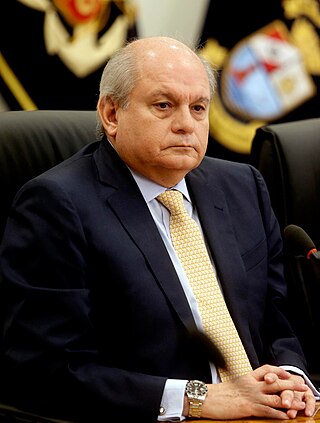
Pedro Álvaro Cateriano Bellido is a peruvian lawyer and politician who served as Prime Minister of Peru from July to August 2020, under Martín Vizcarra's administration. He previously served as Ollanta Humala's minister of defense from July 2012 to April 2015, and prime minister from April 2015 to July 2016.
Julio Armando Guzmán Cáceres is a Peruvian economist, politician, and leader of the Purple Party who ran for President in the 2021 general elections getting just over 2% of valid votes. He was formerly the leader of the All for Peru political party, running for president for the party in the 2016 general elections, but was disqualified, due to the irregularities of the nomination process.

Peruvians for Change was a centre-right party in Peru.
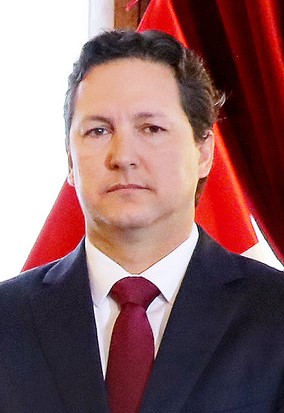
Daniel Enrique Salaverry Villa is a Peruvian architect, businessman and politician. Between 2016 and 2019, he served in Congress representing the Department of La Libertad. Elected to Congress under the Fujimorist Popular Force party, he was the party's spokesperson for a year, and was President of the Congress from 2018 to 2019. He ran as a candidate for the presidency of Peru for the We Are Peru party in the 2021 general elections.

The Purple Party is a centrist, liberal and progressive Peruvian political party. The color purple was chosen to represent the blending of red and blue, the colors of left and right-wing parties in Peru, symbolizing the centrist ideology of the party.

General elections were held in Peru on 11 April 2021. The presidential election, which determined the president and the vice presidents, required a run-off between the two top candidates, which was held on 6 June. The congressional elections determined the composition of the Congress of Peru, with all 130 seats contested.
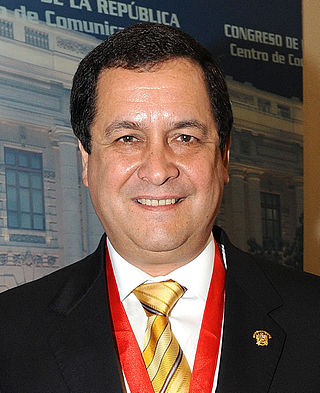
Luis Carlos Antonio Iberico Núnez is an Argentine-born Peruvian journalist and politician. Throughout his journalistic career, he served in various news stations during the 1980s and 1990s. He gained prominence for his fight against the Alberto Fujimori administration, denouncing several allegations of corruption involving the press. Alongside Fernando Olivera, he presented the first "Vladi-videos" that would prove the major corruption operations headed by Intelligence Chief Vladimiro Montesinos. His role in Fujimori's downfall would gain him support in a career in politics.
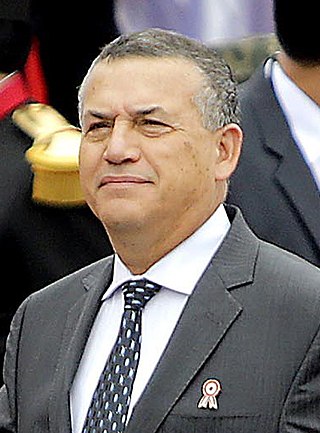
Daniel Belizario Urresti Elera is a Peruvian retired army general and politician who served as Minister of the Interior in the administration of President Ollanta Humala from 2014 to 2015, and as a Congressman representing Lima from 2020 to 2021. He is currently serving a sentence of twelve years in prison for the murder of journalist Hugo Bustíos.

Peru Action (previously Peru Nation is a minor centre-right Peruvian political party.
Fernando José Cillóniz Benavides is a Peruvian engineer and politician who served as Governor of the Ica Region from January 2015 to December 2018, elected as invited candidate under Popular Force.




















